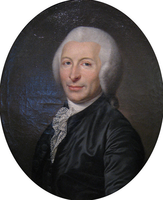










Dr. Joseph-Ignace Guillotin was a French physician and freemason who proposed on 10 October 1789 the use of a device to carry out death penalties in France, as a less painful method of execution. While he did not invent the guillotine, and in fact opposed the death penalty, his name became an eponym for it. The actual inventor of the prototype was Antoine Louis.
Guillotin wrote an essay to get the degree of Master of Arts from the University of Bordeaux. This essay impressed the Jesuits so much that they persuaded him to enter their order and he became a professor of literature at the Irish College at Bordeaux. He left, however, after a few years and travelled to Paris to study medicine, becoming a pupil of Antoine Petit. He gained a diploma from the faculty at Rheims in 1768 and later won a prize given by the Paris faculty, the title of Doctor-Regent.
In 1784, when Franz Mesmer began to publicize his theory of "animal magnetism", which was considered offensive by many, Louis XVI appointed a commission to investigate it and Guillotin was appointed as a member of it along with Benjamin Franklin and others.
In December 1788 Guillotin drafted a pamphlet entitled Petition of the Citizens Living in Paris, concerning the proper constitution of the States-General. As a result he was summoned by the French parliament to give an account of his opinions, which served to increase his popularity and on 2 May 1789 he became one of 10 Paris deputies in the Estates-General of 1789, and was secretary to the body from June 1789 to October 1791.
As a member of the assembly Guillotin mainly directed his attention towards medical reform, and it was on 10 October 1789, during a debate on capital punishment, that he proposed that "the criminal shall be decapitated; this will be done solely by means of a simple mechanism."The "mechanism" was defined as "a machine that beheads painlessly". His proposal appeared in the Royalist periodical, Actes des Apôtres.
At that time, beheading in France was typically done by axe or sword, which did not always cause immediate death. Additionally, beheading was reserved for the nobility, while commoners were typically hanged.Dr. Guillotin assumed that if a fair system was established where the only method of capital punishment was death by mechanical decapitation, then the public would feel far more appreciative of their rights.
Despite this proposal, Guillotin was opposed to the death penalty and hoped that a more humane and less painful method of execution would be the first step toward a total abolition of the death penalty. He also hoped that fewer families and children would witness executions, and vowed to make them more private and individualized. It was also his belief that a standard death penalty by decapitation would prevent the cruel and unjust system of the day.
On 1 December 1789, Guillotin made a remark during a follow-up speech to the Assembly about capital punishment. "Now, with my machine, I cut off your head in the twinkling of an eye, and you never feel it!" The statement quickly became a popular joke, and few days after the debate a comic song about Guillotin and "his" machine circulated, forever tying his name to it. The Moniteur of 18 December 1789 deplored the joking but repeated Guillotin's "twinkling of an eye" statement for posterity.For the remainder of his life, Guillotin would deeply regret that the machine was named after him.
Towards the end of the Reign of Terror, a letter from the Comte de Méré to Guillotin fell into the hands of the public prosecutor, Fouquier-Tinville in which the Count, who was to be executed, commended his wife and children to Guillotin's care. The authorities demanded Guillotin inform them of the whereabouts of the Count's wife and children and, as Guillotin either would not or could not give the information, he was arrested and imprisoned. He was freed from prison in the general amnesty of 9 Thermidor 1794 after Robespierre fell from power, and abandoned his political career to resume the medical profession.
Guillotin became one of the first French doctors to support Edward Jenner's discovery of vaccination and in 1805 was the President of the Committee for Vaccination in Paris. He also founded one of the precursors of the National Academy of Medicine.
The association with the guillotine so embarrassed Dr. Guillotin's family that they petitioned the French government to rename it; when the government refused, they instead changed their own family name. By coincidence, a person named Guillotin was indeed executed by the guillotine – he was J.M.V. Guillotin, a doctor of Lyons.This coincidence may have contributed to erroneous statements that Guillotin was put to death on the machine that bears his name; however, in reality, Guillotin died in Paris in 1814 of natural causes,and is now buried in the Père-Lachaise Cemetery in Paris.